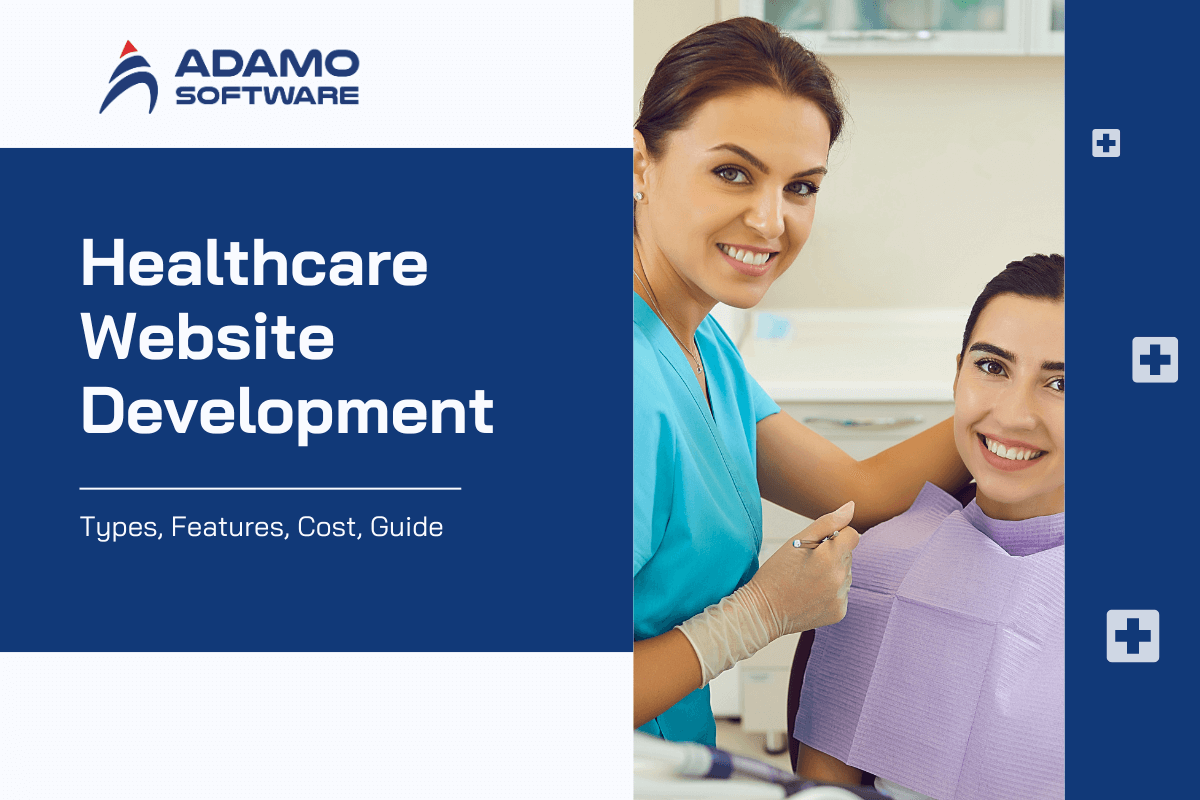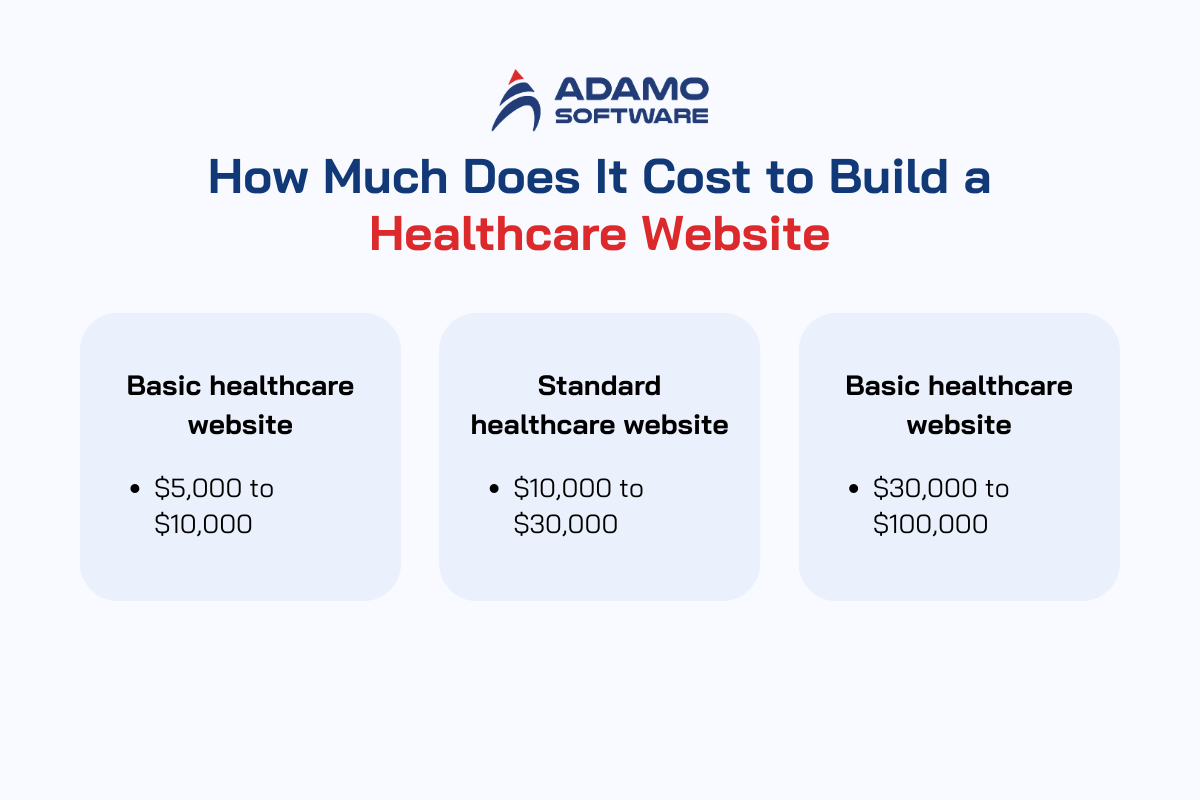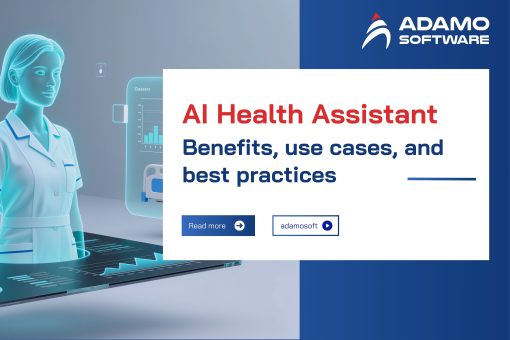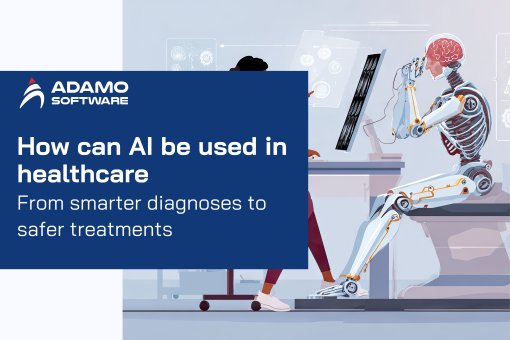Healthcare Website Development: Types, Features, Cost, Guide

In the digital age, developing a healthcare website is essential for healthcare facilities to provide efficient patient services. From hospitals to drug suppliers and stores, they may all want to build their own professional health, medical, or pharmaceutical websites. The aim is to make it easier for patients to search for information about services and products, make medical appointments, buy medicine, etc. Let Adamo Software analyze more details on healthcare website development.
Through this blog, you will find the reasons why healthcare organizations need a custom web. Besides, types of web development for healthcare and must-have features of healthcare websites are also discussed. Additionally, you will also know how much it costs to build a healthcare website, how to build a healthcare website, and current trends in healthcare website development. Read our post for more detailed, well-researched, and up-to-date information.
I. Why do Healthcare Organizations Need a Custom Web?
More and more people are choosing clinics with the help of Google or other search engines. Besides, before making an appointment with a doctor, patients will visit the website they like and carefully study all the information it provides. These pieces of information can be related to medical examination and treatment services, examination time, facilities, costs of each service, etc. Therefore, healthcare website development is currently one of the most important things for healthcare institutions to do. The website is a channel to sell medical services and related products. Here are some reasons why healthcare organizations need a custom web.
1. Branding and Credibility
A website with full information and an easy-to-use interface will increase the prestige and brand of the medical facility. Thanks to the website, medical facilities can demonstrate to their customers who are also their patients that they are worthy of patient trust. Patients are more likely to feel confident in the quality of care they will receive if the organization presents itself well online.
During the healthcare website development, clinics and hospitals may want to customize all branding elements, such as logos, color schemes, and messaging. This ensures that their branding and images are consistent across all online and offline platforms.
Consistent branding reinforces the healthcare organization’s identity and helps build brand recognition. In addition to general information, healthcare facilities can also show detailed information on profiles of medical staff, including their qualifications, experience, and specializations. This transparency helps build trust and reassures patients about the quality of care they will receive.
2. Increased competitiveness
Many hospitals and healthcare facilities are operating in the market. Therefore, to appeal to patients, a medical provider must use all the best competitive means. Making the most of web resources is one of these means. A custom website allows healthcare organizations to showcase their unique values, mission, and vision. This helps patients understand what the organization stands for and what makes it different from others.
Besides, healthcare organizations in their healthcare website development may think of highlighting their areas of expertise, special services, and advanced technologies on their websites. This positions them as leaders in their field.
3. Enhanced patient experiences and loyalty
A website is a great tool to provide the best user experience and ensure patient loyalty. It would be great if a healthcare website could save the patient’s medical history. This helps patients monitor their health more easily and carefully. A clinic or hospital can build long-term relationships with their patients with a customized website.
This website is a place where patients can find reliable information, access services, and communicate with healthcare providers. When thinking of a healthcare website development, treatment centers can display patient feedback right on the home page. Positive feedback from other patients can significantly enhance the organization’s credibility.
Overall, a custom website significantly enhances a healthcare organization’s competitiveness, differentiating it from other healthcare providers. It is a tool to raise a clinic or hospital’s images, and brands, thereby attracting patients through useful information and positive feedback.
Wanna have your own healthcare website developed but haven’t found the right type of website? Don’t worry, let’s keep reading for some outstanding types of healthcare website development!
II. Types of Web Development for Healthcare
Healthcare web development encompasses the design and building of websites and applications to address the diverse requirements of the healthcare industry. There are many types of healthcare website development. Here are some of the main types.

1. Electronic Health Record System (EHR)
An EHR is one of the most popular types of web development for healthcare. It also represents the most common use of healthcare cloud services. Every individual can have a comprehensive digital health record, containing important information such as demographics, medical history, and test results. Also, medical histories and diagnoses are stored in the EHR. The electronic records are accessible to both public health care providers and owners.
EHRs streamline healthcare processes by allowing doctors to make real-time updates without the need for traditional hard copies. At the same time, EHR also helps notify patients of scheduled tests and easily track prescriptions. In addition, it can integrate a financial module for invoicing and payments.
2. Telehealth platforms
Telemedicine technology has become important, especially in areas where healthcare services are limited or inaccessible. A telehealth platform is among the healthcare website development types that support this. It allows remote consultations between patients and healthcare providers through video conferencing and secure messaging.
3. Medical E-commerce websites
If you are not operating a clinic or hospital but specializing in pharmaceuticals, you may want to think of the medical E-commerce websites. These websites can act as online pharmacies that sell medical supplies, pharmaceuticals, and health-related products. So, what you need is to design product catalogs, shopping carts, secure payment gateways, customer reviews, and order tracking on your website.
4. Patient portals
You may want to develop a patient portal website that enables your patients to access their medical records. Your website needs to provide complete information about the patient’s medical condition, diagnostic results, ultrasound images, x-rays (if available), etc. Besides, through the website, your patients can make appointments and communicate with you.
5. Health information websites
Unlike other healthcare websites, this type of healthcare website development purely provides information. These pieces of information are related to health, wellness, medical conditions, treatments, and preventive care. Such websites play a crucial role in educating the public, assisting patients in making informed healthcare decisions, and encouraging healthy behaviors.
To make the most use of the website, you may want to continuously update educational articles and blog posts covering a wide range of health topics. Comprehensive guides and frequently asked questions that provide detailed information on specific health conditions and treatments are also needed on your website. Besides texts, your content must contain illustrative images and videos. They make it easier for the readers to get and understand the information related to the healthcare sector.
In general, each type of healthcare website development serves a specific purpose and caters to the diverse needs of patients, healthcare providers, researchers, and administrators. These platforms optimize patient care, operations, and overall health. So, what features must a healthcare website have? Let’s keep reading!
III. Must-have Features of Healthcare Website
A healthcare website should have a set of essential features to ensure it meets the needs of patients, healthcare providers, and administrative staff. Here are some features you may want to note for your healthcare website development.

1. User-friendly interface
A healthcare website must have a user-friendly interface so that readers can easily find the information they need. You may want to create a clear menu hierarchy with drop-downs for easy navigation, thereby enhancing patient experience. Besides optimizing your website on PC, you also need to ensure easy access and usability across all mobile devices. Additionally, don’t forget to include a robust search function with filter options for service type, location, and health condition to refine search results. A call-to-action button such as contacting health professionals, booking appointments, etc., is also needed.
During your healthcare website development, it is crucial to focus on the website layout. How a healthcare website looks significantly impacts user impressions. Consider consistent branding, quality imagery, and responsive website design which can be adjusted seamlessly to different screen sizes and devices.
2. Comprehensive information
A healthcare website must provide comprehensive information about the healthcare facility. You must provide general information about the hospital and clinic, including mission and vision, hospital (pharmacy) structure, medical staff, facilities, certifications, etc. Currently, patients increasingly need to learn more information, especially about the doctors before treatment. Therefore, a separate doctor page should be deployed on your healthcare website development. Avoid providing sketchy information, including only name and position, instead, full information will be more convincing. Patients will trust more when they see information about the doctors’ qualifications, specialties, and contact details.
3. Educational content
Not only the interface but also unique content is a necessary feature of a medical website. Content should include health tips, articles, patient stories, and FAQs to educate and empower readers who can be patients, healthcare professionals, or the general public. You may want to regularly update content on health topics, wellness tips, and medical news. Besides, you may want to integrate videos, infographics, and podcasts that provide valuable health information.
4. Data security
Robust data security is among the indispensable features you should consider for your healthcare website development. Here are essential features to ensure data security.
- SSL Certificates
To secure personal and medical information, you should use SSL certificates. This certification helps encrypt data transmitted between the user’s device and the website.
- Regular software updates
Your healthcare website needs to be updated regularly. Thanks to the website and plugin updates, you can protect your website against vulnerabilities.
- HIPAA Compliance
Ensuring HIPAA compliance is critical for protecting patient information and maintaining trust in healthcare services. You should ensure the website adheres to the Health Insurance Portability and Accountability Act (HIPAA) regulations.
- Ongoing security assessments
You need to regularly conduct security audits and penetration testing to identify and address potential threats. Some practices for conducting effective ongoing security assessments include regular vulnerability scans, penetration testing, and risk assessment. Data backup and recovery testing are also needed. You must conduct t frequent backup tests to verify data integrity and ensure successful restoration in case of data loss.
5. Online appointment scheduling
Online appointment scheduling is a vital feature of healthcare websites. This feature is not only helpful for patients but also healthcare providers as well. During your healthcare website development, don’t forget to add this feature to your web. It allows your patients to easily book, reschedule, and manage their appointments. Thanks to this, patient experience and satisfaction can be enhanced. Real-time schedules help healthcare providers avoid double booking and ensure accurate scheduling.
6. Online payments
Online payment functionality is also a crucial feature for healthcare websites. It enables patients to manage their financial obligations conveniently and securely. With this feature, the billing process and administrative workload can be simplified. You may want to provide your patients with electronic invoices detailing their charges, services rendered, and payment due dates. Besides, your healthcare website development needs to be associated with creating favorable conditions for patients to track their billing history.
7. Accessibility
Accessibility is an important aspect of medical website design. Adhering to accessibility standards such as the Web Content Accessibility Guidelines ensures that all users, including those with disabilities, can access and navigate the website effectively. Let’s implement accessible design elements such as compatibility with assistive technologies, clear language, and alternative text for images.
Overall, during your healthcare website development process, you must add the necessary features to your website. Besides the above elements, your website also needs to have an online chatbot, 3D clinic tour feature, and doctor interaction feature.
You can explore about Digital health platform development: A comprehensive guide here.
IV. How Much Does It Cost to Build a Healthcare Website
Depending on the complexity, features, requirements, and the development team’s expertise, your healthcare website development will cost differently. Key cost factors include design and user experience, functionality and features, and compliance and security. Besides, the development team and maintenance and support also affect the cost of building a healthcare website. Let’s explore the price ranges for each type of healthcare website.

1. Basic healthcare website
A basic healthcare website provides essential information and core features. It normally has the basic informational pages, contact form, and blog or news section. Building a basic healthcare website typically costs between $3,000 and $10,000. Here’s the breakdown of the cost.
- Domain and hosting: $110 to $650 annually
- Design and development: $500 to $5,000
- Creating content: $850 to $3,500
- Core features: $900 to $3,300
- Testing and launch: $700 to $2,000
Besides these fixed costs, your basic healthcare website development may also have some additional costs. These costs include the maintenance cost which is from $500 to $2,000 per year, and the future enhancement cost.
2. Standard healthcare website
Compared to the basic healthcare website, the standard healthcare website is more costly. There are more features in this type of website. Besides basic features, your website will have a patient portal, appointment scheduling, secure messaging, and basic EHR integration features. Here’s a summary of the costs.
- Domain and Hosting: $260 to $1,250 per year
- Design and Development: $5,000 to $10,000
- Content Creation: $1,600 to $6,000
- Advanced Features: $7,000 to $18,000
- Additional Functionalities: $2,000 to $6,000
- Testing and Launch: $1,500 to $4,000
Overall, a standard healthcare website offers a robust online presence with essential features, with costs ranging from $10,000 to $30,000. This investment yields a professional, user-friendly website boosting patient engagement and efficiency.
3. Advanced healthcare website
Advanced healthcare websites offer comprehensive features including patient portals, online payments, telehealth, detailed provider profiles, and EHR integration. The domain and hosting for advanced healthcare website development cost $610 to $2,350. Whereas, this number is from $10,000 to $20,000 for designing and developing the web. In general, an advanced healthcare website offers a robust, feature-rich platform that significantly enhances patient engagement. Investing $30,000 to $100,000 in an advanced healthcare website creates a professional, feature-rich, and secure online presence to meet modern healthcare demands.
4. Enterprise-Level healthcare website
Your enterprise-level healthcare website development process may involve adding the most advanced features to your website. These features include telehealth capabilities, AI-driven tools, extensive third-party integrations, high-level security and compliance measures, and scalability for high-traffic and large user bases. Each of these features costs differently. For example, a comprehensive patient portal costs you from $10,000 to $20,000 while the online payment feature costs $5,000 to $10,000. Overall, the cost of developing an enterprise-level healthcare website ranges from $100,000 to more than $500,000.
In general, building a healthcare website involves several cost factors. It’s essential to clearly define your requirements and budget to choose the right level of complexity and features for your healthcare website.
V. Step-by-step Guide for Healthcare Website Development
Creating a healthcare website involves a series of steps to ensure it meets the needs of both the healthcare provider and the patients.

1. Defining your needs
Defining your needs is the first and foremost step in your healthcare website development. You must identify what kind of healthcare website you want to create. Whether it is a corporate website or a web app, you should learn if it can solve your audiences’ problems. This step is crucial, as it sets the direction for your entire website development. It ensures that your final website meets the specific requirements of your healthcare organization and serves your patients effectively.
Once you have determined what you want your website to do, you need to make a list of the functions it needs to have. Let’s note all essential basic features, advanced features, and administrative tools. Besides, set a budget for the project, considering design, development, content, and ongoing maintenance costs.
2. Doing research
Before going to the website designing phase for your healthcare website development, it is essential to understand the needs and preferences of your target audience. The readers of your website can be patients, healthcare providers, caregivers, and families. In this step, you will analyze your audiences, and find out their problems, demographics, etc. By analyzing user behavior and expectations, you can identify common tasks, pain points, and areas for improvement. Conducting thorough user research and analysis is the foundation for creating a successful medical website.
Besides researching your audiences, you should also perform competitor analysis. This is to identify industry standards, strengths, weaknesses, and opportunities for differentiation. You may want to compare the features offered by competitor websites and gather ideas from their web.
3. Choosing the Right Platform
The next step is to choose the platform for building the website. Depending on your needs, you can choose different content management systems as a base for your website. They can be WordPress, Drupal, or a custom-built solution. Besides, don’t forget to choose the right technology stack. Adamo Software recommends using HTML5, CSS3, JavaScript frameworks, backend technologies like Node.js, Python, or Ruby, etc.
4. Designing the User Experience (UX) and User Interface (UI)
Designing the UX and UI is the next step in your healthcare website development. In this step, your objective is to create an intuitive and user-friendly design. Healthcare websites demand a user-centric design that prioritizes clear navigation and easy access to information. The UX/UI must be adaptable to different devices, and fully dedicated to medical and healthcare functionalities. Fonts, colors, images, and CTAs must be focused on.
5. Developing your website
Once you have finished the four above steps, now, it’s time for you to develop your website. This stage involves translating the design and requirements into a functional and interactive website. During your healthcare website development, you must ensure the website meets all necessary security standards and compliance requirements. In this step, you also need to integrate a content management system to facilitate easy content updates and management.
6. Testing
In this step, you will test the website thoroughly to ensure it functions correctly and is free of bugs. These tests include functional, usability, security, and performance testing. You must see if your website works as intended, and whether there are any user experience issues to fix. Besides, data protection and compliance must also taken into consideration. Additionally, you must test to ensure your website can handle high traffic and load.
Finished all the above steps? Now, it’s time to have your healthcare website accessible to your audiences. Overall, the development phase is a critical stage in healthcare website development. By following this step-by-step guide, you can build a healthcare website that meets your needs and provides an excellent user experience for patients and healthcare providers.
VI. Current Trends in Healthcare Website Development
The healthcare industry is constantly evolving, with new technologies, regulations, and patient expectations shaping the digital experience. Thus, you need to stay up-to-date with current trends to optimize your website. This ensures that your healthcare website remains relevant, user-friendly, and efficient. Let’s explore some of the latest trends in healthcare website development.
1. Telehealth integration
As mentioned, telemedicine technology is more and more popular among patients. Therefore, incorporating telehealth capabilities directly into healthcare websites has become a trend in healthcare website development. Video consultants, remote monitoring, and virtual waiting rooms are some key features.
2. Integrating with wearable medical devices
Integrating your website with wearable medical devices is also a trend in developing a healthcare website. Wearable medical devices, such as fitness trackers, smartwatches, and specialized medical wearables, are becoming increasingly popular for continuous health monitoring. Integrating these devices with healthcare websites offers numerous benefits for both patients and healthcare providers. Continuous monitoring, early detection of health issues, and remote care are some benefits of this integration.
3. Personalized user experiences
Leveraging data and AI to offer personalized content and services on healthcare websites is also becoming popular. By tailoring content, services, and interactions to individual users, healthcare organizations can enhance patient engagement, satisfaction, and outcomes. Here are some examples of personalized user experiences.
- Custom health portals
- Dynamic content delivery
- Interactive health tools
Personalized user experiences are revolutionizing healthcare websites by making them more relevant, engaging, and effective for users. This trend not only improves patient satisfaction and outcomes but also enhances the efficiency of healthcare providers.
Overall, staying current with trends in healthcare website development is essential for providing superior patient care and maintaining a competitive edge. By adopting these trends, healthcare organizations can effectively address evolving patient needs and deliver superior care in the digital health landscape.
VII. Adamo Software – A Trusted Partner for Healthcare Web Development
When it comes to developing a robust, secure, and user-friendly healthcare website, choosing the right development partner is crucial. Adamo Software can be your trusted partner for healthcare website development.

As one of Vietnam’s leading app development companies with experienced and professional experts, we are confident in delivering high-quality healthcare website solutions. Telehealth/ telemedicine solutions, remote patient monitoring, on-demand healthcare solutions, and wearable medical devices, are valuable solutions that we offer. Here’s why Adamo Software is the ideal choice for your healthcare web development needs.
- Expertise in the healthcare industry
- Comprehensive service offerings
- Providing innovative solutions
- Creating responsive, accessible websites
- Providing robust security measures
- Providing ongoing support and maintenance
Still confused about choosing a unit to help you with your healthcare website development? Don’t hesitate to contact us now. By partnering with Adamo, you can ensure that your digital solutions are reliable, secure, and tailored to meet the unique needs of the healthcare industry.











